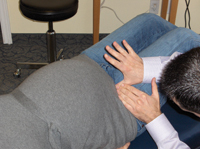
Technique Toolbox: Adjusting the pregnant patient using the Webster technique
By John Minardi BHK DC
Features Clinical TechniquesIn a pregnant patient, the concept of wellness takes on a whole new meaning. Instead of simply trying to achieve wellness for the expecting mother, we are also striving to attain wellness for her unborn child.
A special thank-you goes to Dr. Jeanne Ohm and the ICPA, for their contributions to this article.
 |
|
| Picture 1. Doctor approximates patient’s Heels to Buttocks to assess resistance. Advertisement
|
In a pregnant patient, the concept of wellness takes on a whole new meaning. Instead of simply trying to achieve wellness for the expecting mother, we are also striving to attain wellness for her unborn child. Unfortunately, during pregnancy, obstacles can arise to compromise a pregnant patient’s health. A baby’s inability to position itself into a proper vertex position, and a mother’s inadequate nutritional intake, are just two examples of factors that can lead to serious complications. In these situations, a chiropractor must utilize his/her technical tools and nutritional expertise, to return the mother, and the child, to a state of well-being.
Research involving pregnancy and chiropractic care mainly focuses on the resolution of pain.1,2 However, there is also a growing body of evidence that discusses how chiropractic, and specifically the Webster Technique, has improved birth outcome, by restoring biomechanical balance.3
The literature also suggests that many dietary regimes lack the essential nutrients required for a healthy pregnancy, and that this can lead to a multitude of neurological complications for the unborn child.4,5,6,7
In this edition of Technique Toolbox, I will describe the Webster Technique in detail. I will also discuss which nutritional components are essential for a healthy pregnancy, and why these nutrients are so important.
 |
|
| Picture 2. Patient’s left leg does not approximate Buttocks, indicating an increased resistance and ipsilateral posterior sacral base.
|
THE WEBSTER TECHNIQUE
The Webster Technique was created by Dr. Larry Webster, founder of the International Chiropractic Pediatric Association (ICPA). This technique was specifically designed to detect and correct for pelvic subluxations that occur in a pregnant patient. Furthermore, the technique also aspires to restore the pelvic and uterine supporting structures. If a subluxation complex is present, and allowed to persist in the pregnant patient, the resulting soft tissue tension in the pelvis may produce uterine constraint. This constraint may prevent the baby from comfortably assuming an optimal fetal position, which may affect birth outcome.
So, when should a chiropractor perform this technique?
The following analysis – considered to be the Classic Webster Technique Analysis (see Pictures 1 and 2) – should be performed on every pregnant patient throughout pregnancy, and treatment should be carried out on those who have the relevant indications.
First, place the pregnant patient in the prone position.
- Flex both legs toward the patient’s buttocks (Heel to Buttocks).
- In “normal” cases, equal resistance will be present bilaterally. In these cases, this adjustment procedure is not indicated. However, if greater resistance is present on one side, move on to the next step in the analysis.
- Locate the side of most resistance (i.e., where one heel is farther away from the buttocks).
 |
|
| Picture 3. Doctor positioning for correction of a left posterior sacral base subluxation
|
The side where there is the greatest resistance indicates the presence of an ipsilateral posterior sacral base. When this is present, move on to the treatment protocol.
WEBSTER TREATMENT PROTOCOL: A TWO-STEP PROCEDURE
Step 1 (See Picture 3)
The doctor will adjust the subluxated posterior sacral base:
- Patient: prone, with pregnancy pillows under stomach.
- Doctor: on affected side.
- Table: pelvic drop piece set to ready position.
- Contact: thumb pad or pisiform on sacral base medial to PSIS.
- Stabilization: on contact hand.
- LOC: P-A, use a light thrust due to lax pelvic ligaments.
The doctor is seeking an equalization of resistance during leg flexion. This equalization should take place before continuing to Step 2.
Step 2 (See Picture 4)
- Place the patient in supine position.
- On the side opposite to the sacral adjustment, draw a line 45 degrees lateral and inferior from the umbilicus.
- Draw another line from the ASIS inferior and medial 45 degrees.
- Where the two lines bisect, hold an I-S contact with your thumb (three to six ounces of pressure). The doctor is now contacting the round ligament.
- Rotate thumb contact from the bisect point 15 degrees in either direction until tension is palpable.
- Hold the thumb contact for one to two minutes or until ligament tension subsides.
- Stop at this point.
 |
|
| Picture 4. Doctor contacts on the Round Ligament, contralateral to the sacral base correction.
|
Specific Webster analysis and sacral adjustments should be continued until birth to ensure maternal pelvic biomechanical balance and optimal fetal positioning.
I must stress that there have been several advancements, made to the technique by Dr. Ohm, and her associates, that have enhanced this body of work. There is a certification course dedicated to teaching all of the physiological components involved, as well as the advanced modifications that have been added. Remember, I have described only the tip of the iceberg, here. There can be a host of anatomical variants, physiological factors, and unique complications, throughout pregnancy, that can alter the course of treatment. The only way to truly learn this technique correctly, and to ensure optimal results for the patient, is to enrol in the seminar.
NUTRITION IN PREGNANCY
In addition to chiropractic adjustments, proper nutrition is vital in pregnancy. Not only have physical disorders been linked with poor nutrition before and during pregnancy, but neurological disorders and handicaps are also a risk.4,5,6,7 Pre-pregnancy, nutrition serves as the primary process of building up the immune system.7 Ingesting proper nutrients is always important, however, and, therefore, it is essential that the expecting mother focus on the following, through diet or supplementation.
Here are the “Fab-Five” required daily:
- Magnesium and zinc – important for the binding of hormones at their receptor sites.6,7
- Folic acid – important for the regular growth of the follicle, and preventing neural tube defects.5,7
- Vitamin D – important for calcium absorption and to reduce the likelihood of rickets.4
- Vitamin B12 – reduces the chances of infertility and neurological defects.5,7
By combining chiropractic adjustments with nutritional guidance, the chiropractor can help restore health, balance and well-being for the pregnant patient.
If you would like to learn more about restoring wellness to a pregnant patient, please go to www.icpa4kids.com. Until next time…
Adjust with Confidence.
If you have any suggestions, or if you have a technique that you would like to see featured in a future edition of Technique Toolbox, please contact Dr. Minardi at johnminardi@hotmail.com. •
REFERENCES:
- Stuber, KJ et al. Chiropractic treatment of pregnancy-related low back pain: A systematic review of the evidence [review]. JMPT. 2008. Jul-Aug; 31(6):447-454.
- Borggren, CL. Pregnancy and chiropractic: a narrative review of the literature. JCM. 2007. Jun; 6(2):70-74.
- Thomas JC. The Webster Technique in a 28 year old woman with breech presentation & subluxation [case report]. JVSR. 2008. Apr; (7): Online access only pp. 1-3.
- Weisburg, P. et al. Nutritional rickets among children in the United States: review of cases reported between 1986 and 2003. Am J Clin Nutr. 2004. Dec; (80):1697S-705S.
- Del Rio Garcia, C. Maternal MTHFR 677C>T genotype and dietary intake of folate and vitamin B(12): their impact on child neurodevelopment. Nutr Neurosci. 2009. Feb; 12(1):13-20.
- Bourre, JM. Effects of nutrients (in food) on the structure and function of the nervous system: update on dietary requirements for brain. Part 1: micronutrients. J Nutr Health Aging. 2006 Sep-Oct; 10(5):377-85.
- www.wikipedia.org/pregnancy 2009
 Dr. John Minardi is a 2001 graduate of CMCC. A Thompson-certified practitioner and instructor, Dr. Minardi is the creator of the Thompson Technique Seminar Series and author of The Complete Thompson Textbook – Minardi Integrated Systems. In addition to his busy lecture schedule, Dr. Minardi operates a successful private practice in Oakville, Ontario. E-mail: johnminardi@hotmail.com, or visit www.ThompsonChiropracticTechnique.com .
Dr. John Minardi is a 2001 graduate of CMCC. A Thompson-certified practitioner and instructor, Dr. Minardi is the creator of the Thompson Technique Seminar Series and author of The Complete Thompson Textbook – Minardi Integrated Systems. In addition to his busy lecture schedule, Dr. Minardi operates a successful private practice in Oakville, Ontario. E-mail: johnminardi@hotmail.com, or visit www.ThompsonChiropracticTechnique.com .
Print this page